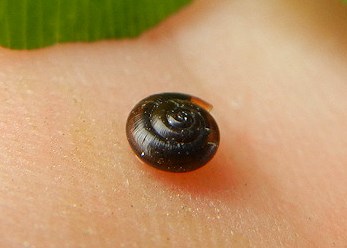
Nutrition
Terrestrial snails obtain their food from their current environment with the use of a radula. A radula is a rasping organ that is used for feeding. This feeding structure contains chitinous teeth that is specialized for scraping, tearing or drilling into prey (Hickman et al., 2008).
Zonitoides nitidus are omnivores. This species is known
to mainly feed on fragments of decaying plants, fungus and algae, or
become a predator of other snails. During most of the year, Z.
nitidus mainly feed on decaying plants. However, from June to
August, Z. nitidus is known to prey on other snails and
bivalve species who live in wetlands, river margins and other
habitats of Z. nitidus. One snail that Z.
nitidus predates is Galba truncatula, a freshwater
pulmonate snail (Rondelaud, 2006).
The predation of Z. nitidus on G. truncatula depends on many aspects. Temperature and soil moisture play a big role on the predation state of Z. nitidus. If it’s too damp, Z. nitidus will try to find another more appealing environment to invade. The size of the snails Z. nitidus eats matters as well, this species will only eat medium sized snails, maybe smaller, but never larger than themselves (Rondelaud, 2006).
Terrestrial snails have a complete digestive tract that is complex and highly specialized for food that is eaten by the snail. They also have a single nephridium, which is sometimes referred to as a kidney. This organ differs from a kidney because it filters out excess water and metabolic wastes from the coelomic fluid rather than blood. The nephridium also serve as a mechanism for the transport of gametes from the gonads into the mantle cavity (Hickman et al. 2008).
Most terrestrial snails have an open circulatory system. The open circulatory system consists of a pumping heart, blood vessel, and the blood sinuses. An open circulatory system is not very efficient because the blood is not contained within the blood vessels, instead, it flows out the vessels to some other open sinuses in the body (Hickman et al. 2008).